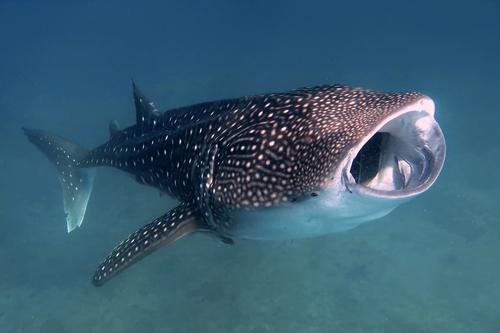
Whale Shark
The Atlantic Bluefin Tuna (Thunnus thynnus) is a majestic and highly migratory species of tuna found in the Atlantic Ocean. Renowned for its size, speed, and commercial value, it plays a critical role in the marine ecosystem. This species faces significant conservation challenges due to its high demand in the global seafood market.
70 150 years
Lifespan
1800 - 2000 cm
Length
Endangered
Conservation Status
5 km/h
Swimming speed
Filter Feeding, Planktivorous
Diet
Highly Migratory, Pelagic Migration
Migration
Appearance Overview
The Atlantic Bluefin Tuna is renowned for its large, streamlined body, built for speed and endurance.
Color
Dark metallic blue above, silvery white below
Body Shape
Torpedo-shaped, streamlined
Fins
Two dorsal fins, the first depressible; small finlets behind second dorsal and anal fins
Keel
Strong lateral keel on caudal peduncle
Length
Up to 13 feet (4 meters)
Weight
Up to 2,000 lbs (907 kg)
Diet
Carnivorous, feeding on a variety of fish, squid, crustaceans, and eels.
Feeding Behavior
An opportunistic predator, the Bluefin Tuna uses its speed and agility to hunt, often feeding near the surface but also diving deep.
Social Behavior
Forms large schools, sometimes segregated by size; highly migratory, capable of crossing entire oceans.
Commercial Relevance
Extremely high value, particularly in the sushi and sashimi markets, where its fatty flesh is considered a delicacy.
Conservation measures
Subject to international fishing quotas, stock management plans, and monitoring efforts by organizations like ICCAT; marine protected areas also play a role.
Status
Endangered
Threats
Overfishing (historically and ongoing), bycatch in fishing gear, habitat degradation, and climate change impacts on prey distribution.
Habitat Distribution
Depth Range
0-1,000 meters (0-3,280 feet), with most common occurrence in the upper 200 meters.
Geographic Range
Widely distributed across the North Atlantic Ocean, from the Gulf of Mexico and the Mediterranean Sea to Norway and Newfoundland.
Preferred Environment
Prefers temperate and subtropical waters; undertakes extensive trans-Atlantic migrations.
Reproduction and Life Cycle
Breeding Habits
Spawns in two main areas: the Mediterranean Sea and the Gulf of Mexico; spawning occurs in warm waters during spring and summer.
Development Stages
Eggs are pelagic and hatch into larvae; juveniles grow rapidly, feeding on plankton and small fish; growth continues throughout their life.
Fecundity
Highly fecund; a large female can produce up to 30 million eggs per spawning season.
Maturity Age
Reaches sexual maturity at around 4-8 years in the Mediterranean and 8-12 years in the Gulf of Mexico.
Faqs about Whale Shark
How long do Atlantic Bluefin Tuna live?
Atlantic Bluefin Tuna can live up to 40 years.
How fast can Bluefin Tuna swim?
They are among the fastest fish in the ocean, capable of bursts of speed up to 43 mph (70 km/h).
Are Bluefin Tuna warm-blooded?
Yes, they are warm-blooded, which allows them to maintain a higher body temperature than the surrounding water, aiding in muscle efficiency during long migrations and deep dives.
Why Bluefin Tuna are good at migration?
Their streamlined bodies and powerful muscles allow them to cross entire oceans.
What are the predators of Bluefin Tuna?
Their main predators are killer whales and some large sharks.
Copyright @ Nature Style Limited. All Rights Reserved.
 English
English